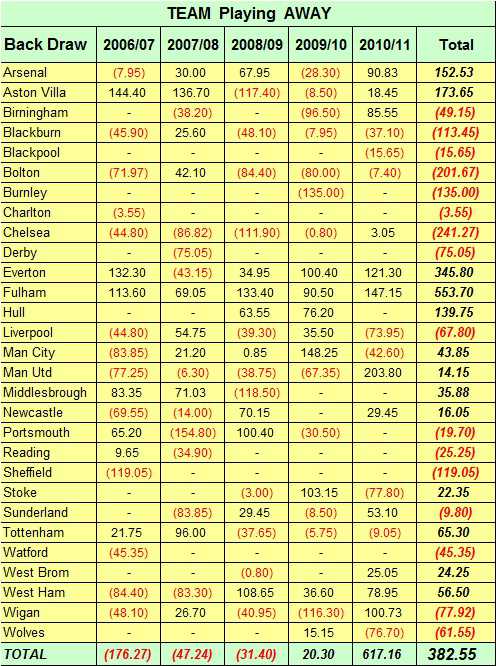
Looking at possible home, draw and away bet combinations
- Teams playing at home: Back or lay home; back or lay the draw; back or lay away
- Teams playing away: Back or lay home; back or lay the draw; back or lay away
As you can see there are 12 variations and one more of these is presented below:

Here, draws don’t look as bad as away results and two teams jump out, Everton and Fulham.
Over the five seasons both clubs finished with more away draws than any other team. Betting continuously with 10 € stakes on the draw in each team’s away matches, winnings over five years would have totalled 345.80 € and 553.70 € respectively.
Having evaluated all 12 tables our conclusions are as follows:
- Back Fulham if they are at home
- Back the Draw if Fulham is away
- Back Manchester City when they are at home
- Back Manchester Utd when they are at home
- Back the Draw when Aston Villa plays at home
This strategy looks quite promising and in none of the past five years would it would have been necessary to increase the initial bank of 50 € (betting with equal stakes of 10 €).
The profit over five years would have accumulated to 1,601.29 € if the bets were placed at prices 10% above the standard Ladbrokes odds. Please note that betting exchange commissions (their ‘tax’ on your winnings) have not been considered in these calculations.
It should also be borne in mind that the system relies on all bets being placed regardless of whether two of your selected teams are playing against each other.
The graph below shows the development of the bank each year if starting with 50 €:

(Starting bank 50 €: Backing Fulham, Manchester City and Manchester United to win at home; Backing the draw in all Aston Villa home games; Backing the draw in all Fulham away matches @ 10 € stake per game)
According to this graph there would never have been the necessity to increase the initial bank if adhering strictly to the 10 € stake per game, and apart from a brief spell during the 2007-2008 season, the bank would never have dropped under its original value of 50 €.
Even in the worst year (2007-2008) the ‘interest’ on the starting capital amounted to 125.54% (on a 50 € starting bank). No bank anywhere in the world offers such high interest on cash investments. In the best year (2008-2009) the ‘interest’ rate on the starting capital was a massive 1,137.10%, through nothing more than employing a simple system of backing three teams to win at home, one to draw at home, and one to draw away from home whenever the circumstances fitted:
Of course, any systematic style of betting requires enormous discipline and it is only possible to win by sticking religiously to the chosen staking plan (in our example 10 € each fixture), without experimentation along the way. The system also relies on a ‘full game’ approach (i.e. no greening-up in-play), and depends on all bets being placed throughout the course of the entire season.
As much as the desire for quick profits is understandable, picking and choosing games, arbitrary changes of stakes, or deviations from the original staking plan will undoubtedly create irregularities in the betting bank, leading to possible chasing of losses, and then perhaps to full loss.
Of course, starting with such a small bank as 50 € and ending-up with just 62.77 € profit at the end of season 2006-2007 is surely not enough to make a living from, but bear in mind the capital return is still 125.54% (no saving account would return as much).
Although the 2008-2009 season would have been much more lucrative with a return of 568.55 € from a 50€ start, this too is still relatively small.









Is there a formula to place bet on all three option and win (whatever happens) Home – Draw – Away
Hi Adam,
if you are referring to arbing/dutching, here’s an article on that topic: Dutching – Ausnutzen von Underround (Backen) & Overround (Layen)
Unfortunately, it’s in German only, so you will have to use Google.Translate to understand it. Sorry! However, I tried hard to write in short sentences so that an automated translation is still understandable.
Have fun! 🙂
Hello Soccerwidow!
I would like to ask that if I calulcate the percentage of draws in 5 seasons of data and for example it’s average is 27, with a standard deviation of 3 % , I have to calculate the average odds for theese events to know that if this is profitable or not?
for example:
24 to 30 % draws percentage
bookmakers are offered for theese events an average of 2,85 odds (35%)
This means that betting always on draws, can bring us profit?
Thanks
Hi sarkec, this isn’t a question which is a straight forward answer. Sorry!
If you wish to work out a Back or Lay the Draw strategy you will need to get a few HDAFU table. There you will find inflection point graphs which help to identify the odds clusters which are long-term profitable.
If it’s guaranteed, why not increase the bank to maximise profit ie £2000 bank, £400 stake a game?
Hi Ethan,
Succesfull betting is not about maximising profits but about managing risk. You may find this article useful: The Science of Calculating Winning and Losing Streaks
Hi Sander,
Ladbrokes is a middle of the road bookmaker and we were attempting to simulate betting exchange odds hence the 10% mark-up on Ladbrokes’ odds (see picture captions).
Hope this helps.
But is assuming 10% on top of Ladbrokes odds not way too much? F.e. if home has an odd of 1.70, no other bookie will have odds of 1.87. So this is definitely a game changer.
Hi Sprocket,
Yes, this sounds about right and highlights the fact that you must always seek to place bets at the highest odds you can find.
If you are still into experimenting why not have a look at the underdog to win at half-time – some very surprising results in that market – especially the away underdog performs extremely profitably in most leagues, although you’ll need to factor in the winning and losing streaks to get a real focus on this market and to calculate a suitable progressive staking plan.
Backing favourites in any market is always a recipe for disaster as they are invariably underpriced, meaning long-term losses in most leagues you can analyse.
Hi, I have been reading your website in an effort to teach myself about probability and I am really enjoying the insights you present, so thank you very much! To be honest, I really had no idea home games were so heavily weighted towards the home team, I had always assumed it was only a 33% chance with the 3 possible outcomes, but with all the data I have looked at so far you are spot on – it is around 45%. To test what I have learnt I just did a quick model of historic data from the 2013-14 EPL season and if you betted $1 on every home team to win ($380), with Ladbrokes returns you would be up 96c at the end of the season. Does that sound about right to you?
I forgot to mention:back draw when villa plays home,back draw when everton plays away,back draw when fulham plays away.
Hi,i want to follow your strategy,aston villa home,everton away,fulham away.i saw that you gathered the results from the last 5 seasons 2006 to 2011.so if i want to find teams that make draws away or at home that produce profit,i need to check the last 5 seasons?thanks
Hi,
You have a real nice yield!
I assume the “system” works in long term due to the fact that you probably contribute to balance the bookie and keeping each bet relativly small, so you will not affect the market or the bookie to much?
I order to spread your risk you need to play a pretty large and diversified portfolio. You also never use your whole bank in one betting round. This automatically reduces the amounts for each bet to relatively small stakes.
For example, you have a bank of 20,000 units, and you risk 20% per betting round –> meaning you are risking 4,000 units. Your betting portfolio consists of around 100 bets, which translates to a risk of 40 units per bet. These kind of amounts certainly do not affect the market.
However, to be honest. Income from betting is a very slow process. There are seldom more than 3 betting rounds a months = 4,000 x 3 = 12,000 turnover. If you are lucky you’ll achieve a 10% Yield on average, meaning 1,200 units per month. But there will be months which produce a deficit, so you have to look at the whole year.
There is an article and also course in preparation on this topic. Just keep checking. We will also certainly email the news when it’s available to everybody.